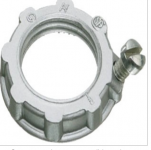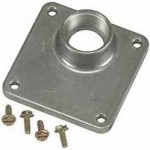On this one I may try to do that next cycle but if I were to write one that is written to clarify that these Myers (and similar brand) conduit hubs are acceptable, I’m not sure what to call them that would differentiate them from the term “listed hubs” that the code uses.
I think these things have to be acceptable. For instance if you buy a Square D fused disconnect and order the service equipment accessories, you have the option of buying what are just the Myers hubs for use with RMC at the service entrance. They aren’t even made by Square D but Square D buys them and gives them a Square D part number as an accessory.
Additionally in some cases of using a fused disconnect as service equipment, the accommodations for a number of grounding, grounding electrode, and bonding conductors is limited and so you may not have enough to run a wire type lug. So you either use one of these or you use a bonding style lock nut with the setscrew that digs into the metal. If you’re coming into the top of the enclosure, this is probably the best option — thought by many to be better than the alternative of using a sealing locknut on the outside of the enclosure and the bonding style lock nut inside.




